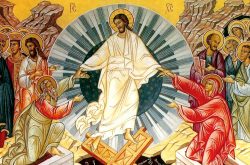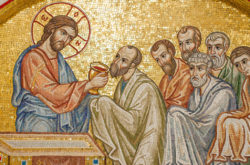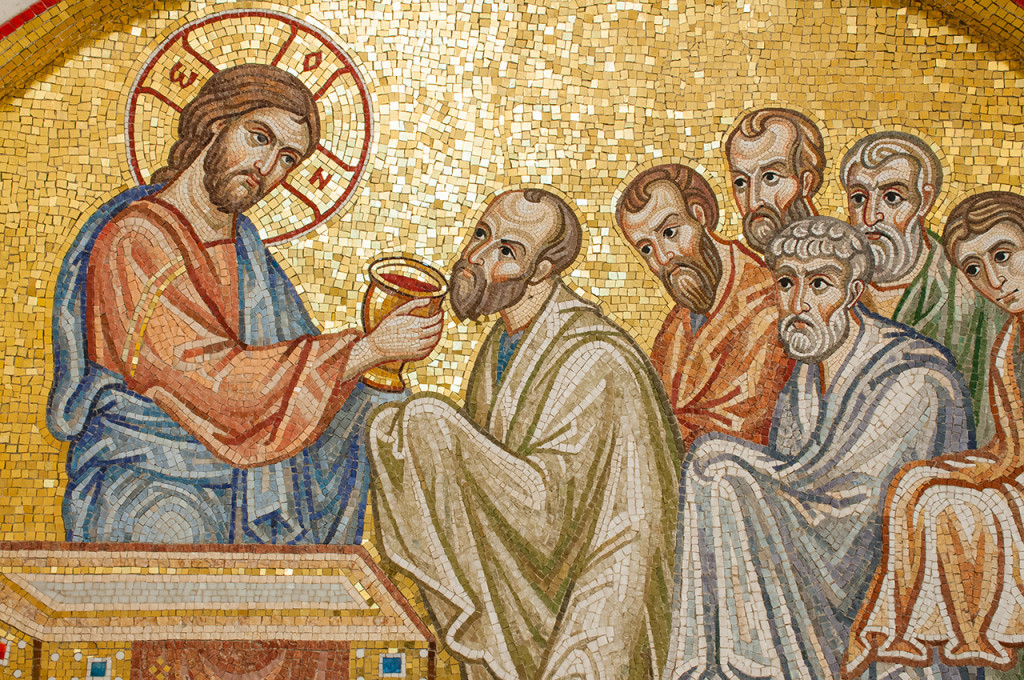 girlpray1當我閱讀M. K. Tanaka那些關於「基督教祈禱」的精闢的文章時,我的內心深受感動,因為,他以深刻又獨道的思考,來談「祈禱」這個主題,觸動了我的內心深處。在這篇文章裡,我只想要再補充一些正教會的觀點,我想,這些觀點對許多人來說可能不太熟悉。
girlpray1當我閱讀M. K. Tanaka那些關於「基督教祈禱」的精闢的文章時,我的內心深受感動,因為,他以深刻又獨道的思考,來談「祈禱」這個主題,觸動了我的內心深處。在這篇文章裡,我只想要再補充一些正教會的觀點,我想,這些觀點對許多人來說可能不太熟悉。 girlbuddhist
因為Tanaka描述了一個八歲女孩的祈禱。在我的生命裡,也曾經遇過這樣的女孩。我有一個好朋友的女兒,名字叫作Mary。她的媽媽有心臟病,隨時都有生命危險,必須藉由特別的機器維持心跳,讓生命延續下去。這個情形,與Tanaka所提到的故事非常雷同。我寫的一切,都是取自真實的故事(但是,關於Mary母親的病情和某些細節,我將會保密,並且直接採用Tanaka原文當中所描述的情節)。此外,我還將Tanaka描述的那個八歲女孩的年齡,提高到十二歲。因為,事實上,Mary的年齡是十二歲,稍後我會提到的一個信仰佛教的女孩,也是這個年齡。
這個女孩留著一頭棕色的長髮,穿著睡衣。她低著頭,緊握著雙手,跪在床邊。正如Tanaka所言,這樣的祈禱形象,正是典型西方社會的祈禱動作,也是東方社會的祈禱形式。讓我們更深入思考這個畫面,一起來看看這個女孩----讓我們叫她Megan----她在晚禱當中,究竟做了哪兩件事情?
girlbuddhist
因為Tanaka描述了一個八歲女孩的祈禱。在我的生命裡,也曾經遇過這樣的女孩。我有一個好朋友的女兒,名字叫作Mary。她的媽媽有心臟病,隨時都有生命危險,必須藉由特別的機器維持心跳,讓生命延續下去。這個情形,與Tanaka所提到的故事非常雷同。我寫的一切,都是取自真實的故事(但是,關於Mary母親的病情和某些細節,我將會保密,並且直接採用Tanaka原文當中所描述的情節)。此外,我還將Tanaka描述的那個八歲女孩的年齡,提高到十二歲。因為,事實上,Mary的年齡是十二歲,稍後我會提到的一個信仰佛教的女孩,也是這個年齡。
這個女孩留著一頭棕色的長髮,穿著睡衣。她低著頭,緊握著雙手,跪在床邊。正如Tanaka所言,這樣的祈禱形象,正是典型西方社會的祈禱動作,也是東方社會的祈禱形式。讓我們更深入思考這個畫面,一起來看看這個女孩----讓我們叫她Megan----她在晚禱當中,究竟做了哪兩件事情?
從佛教徒及正教徒的角度來看基督教的祈禱:對Kenneth K. Tanaka 發表於Buddhist-Christian Studies, 2002的期刊論文所進行的反思。
Christian prayer seen from the eye of a Buddhist and an orthodox Christian. Reflection on journal article by Kenneth K. Tanaka; Buddhist-Christian Studies, 2002
 girlpray1
girlpray1
當我閱讀M. K. Tanaka那些關於「基督教祈禱」的精闢的文章時,我的內心深受感動,因為,他以深刻又獨道的思考,來談「祈禱」這個主題,觸動了我的內心深處。在這篇文章裡,我只想要再補充一些正教會的觀點,我想,這些觀點對許多人來說可能不太熟悉。
 girlbuddhist
girlbuddhist
因為Tanaka描述了一個八歲女孩的祈禱。在我的生命裡,也曾經遇過這樣的女孩。我有一個好朋友的女兒,名字叫作Mary。她的媽媽有心臟病,隨時都有生命危險,必須藉由特別的機器維持心跳,讓生命延續下去。這個情形,與Tanaka所提到的故事非常雷同。我寫的一切,都是取自真實的故事(但是,關於Mary母親的病情和某些細節,我將會保密,並且直接採用Tanaka原文當中所描述的情節)。此外,我還將Tanaka描述的那個八歲女孩的年齡,提高到十二歲。因為,事實上,Mary的年齡是十二歲,稍後我會提到的一個信仰佛教的女孩,也是這個年齡。
這個女孩留著一頭棕色的長髮,穿著睡衣。她低著頭,緊握著雙手,跪在床邊。正如Tanaka所言,這樣的祈禱形象,正是典型西方社會的祈禱動作,也是東方社會的祈禱形式。讓我們更深入思考這個畫面,一起來看看這個女孩—-讓我們叫她Megan—-她在晚禱當中,究竟做了哪兩件事情?
 girl-holy-communion
girl-holy-communion
首先,她對於自己所獲得的一切,向上帝表達感謝。她感謝上帝賜予她食物、衣服、朋友以及家庭。然後,她才向上帝說出其他的願望。從她祈求的禱詞當中,我們可以看到,她請求上帝讓她生病的父親早日康復。當她為父親祈禱時,她的神情更加嚴肅與專注,她將雙手緊握,又將它們緊緊的放在胸前。她注視著天花版,衷心的希望她的父親能早日康復。值得注意的是,Megan的禱詞是大聲念誦的,就好像人與人交談一樣。
Tanaka在文中寫到:「一開始,令我感到好奇的是,對這個小女孩來說,上帝看起來是什麼樣子?上帝是個男生還是個女生?或者兩者都不是?我想,她這樣一個女孩,處在如此溫柔又心思敏銳的年齡,應該會認為上帝是一位男性。如果真是如此,在她心中的上帝,是不是一個留著又白又長的鬍鬚,握著手杖,坐在國王的寶座裡面的老公公呢?除此之外,我還有另一個問題,對這個女孩來說,上帝住在哪裡呢?如果他住在天堂,那麼,她心目中的天堂是什麼樣子呢?還有,她覺得上帝會以何種方式使她的父親痊癒呢?」
然後,Tanaka又提出了一個問題:「如果今天換作是一位信仰佛教的女孩,在佛陀或是菩薩面前為自己生病的父母親『祈禱』,那麼,以上的問題在她的心中,會不會有不同的答案?想到這裡,我的心中忽然出現了一個畫面。有一個女孩,看起來差不多十二歲,她的媽媽的樣子,就像是多年前,我在緬甸的仰光的傳統廟宇當中所見到的婦女一樣。這個女孩穿著華麗的傳統服飾,她的頭髮上,插著一朵又大又鮮艷的紅花。她與母親一同坐在佛前那塊最神聖的區域,她們在大理石地板上恭敬的席地而坐,而佛陀的尊容離她好幾尺高。她用兩隻小小的手掌,緊緊的合十,握著一束花,又將它高舉起來,用殊勝的姿勢,恭敬地將花獻給佛陀。她跪坐在腳跟上,這是緬甸最典型、最普遍的坐姿,在泰國,也是採取這個坐姿。她輕輕闔眼,雙手合十,微微彎曲身體向佛陀恭敬地禮拜。她停留在這個姿勢良久,大概有好幾分鐘,她的媽媽也是如此。我並不知道,她的內心在想著什麼,然而,我很確定,她並不是在『禪定』(meditate)」。
在上文中,有一個重要的觀點,我想要提出來討論。許多人對於佛教的刻板印象就是,佛教徒好像只會「禪定」。然而,亞洲大部分的佛教平信徒,並不會在佛前「禪定」。他們在佛前虔誠的表露自己,或者說「祈禱」。在祈禱的過程當中,他們也表達感恩,然後,向佛請願,或是祈求其他世俗的心願可以成真。在東亞的國家,信仰大乘佛教的佛教徒,皈依那些外表莊嚴華麗的菩薩,例如:觀世音菩薩或地藏王菩薩。菩薩會接受眾人的請願,滿足眾人的心願。在東南亞的國家,盛行著上座部(Theravada)的思想,那裡的佛教徒則皈依釋迦牟尼佛。
我想,這個緬甸的女孩,應該是以釋迦牟尼佛為祈求對象。我可以想像,在她面前有一尊大佛,這尊佛是以莊嚴的坐姿入禪定。假設這個女孩也向佛陀祈求父親的病痛可以早日痊癒,我很想知道,在她的心目中,佛陀究竟是怎樣的形象?是一個寂靜、禪定的佛陀?或是一位英俊、高雅的悉達多王子,勇猛無畏的追求真理?還是,她依據生命的經驗,將佛陀想成是一個「父親的形象」?或者,更有可能的是,在她心中的佛陀,並沒有一個固定的形象,而是以上各種形象和其他形象的融合。無論如何,她心中的佛陀,一定是令她有安全感、滿足感的形象,這樣,她才會從內心深處發出如此虔誠的奉獻心和皈依感,在這種心情當中深入信仰的意義。
Tanaka指出:「我相信,基督教的祈禱具有某種特質,是在佛教徒的祈禱當中是找不到的:就是與至高無上的那一位的交流,換句話說,就是與上帝的交流。」
基督教的祈禱,是一種雙向的溝通,是一種與上帝的對話。相反地,對於那位緬甸的女孩來說,與佛陀對話在實質上是沒有意義的。對她而言,佛陀對她的答覆,就是四季的豐收,或是病體康復。如果她也期望能夠在個人的層次上,與佛陀交流,例如:與佛陀進行一場靈性的對談,這樣我一定會大感驚訝。
甚至,她可能會與佛陀交換一些條件,例如:她願意當一個乖孩子,只要佛陀可以治癒她父親的病痛。或許,她認為條件交換的方式,會讓佛陀更願意傾聽她的願望,並且給她答覆,滿足她個人的願望。在這樣的層次上,佛陀更像是一個關心她、陪伴她的叔叔,可以傾聽她的願望,幫助她解決煩憂。
 girl
girl
然而,Tanaka又說:「大部分的祈禱,都只是一般性的祈禱,而不是『密契的』(mystical)祈禱,甚至,我們可以說,這樣的祈禱距離密契經驗,還有一大段距離。就拿Megan的例子來說,祈禱者尋求高高在上的上帝,而不是內在的上帝。事實上,從這個角度來看,Megan的『祈禱』與佛教徒的『禪定』確實有所分別,在佛教的『禪定』當中,大部分的人都想體驗某種形式的『密契經驗』。」
對於以上精闢的思想,我十分讚賞也很尊敬。在此,我只想要補充一些見解,我想,可敬的Tanaka或許並不知道這些訊息,我真誠的希望能夠與他分享。
如果Megan是一位正教徒(orthodox),那麼她的祈禱必定會成為一種內在的祈禱。
讓我繼續說明下去。如果Megan曾經受洗,成為一位正教徒,她祈禱時,可能會注視著天堂,或是某個耶穌的聖像,讓我們假設是一張正教的聖像畫(icon),這種聖像畫是依據某些特別的規則繪製而成,畫像的顏色和畫風都有特別的意義,它們表達了深刻的神學。在這裡,是色彩而非言語向人們訴說著神學意義。聖像畫將會幫助她跳脫形象的束縛,並且用象徵和色彩的語言與她交談,那是言語所無法表達的神學。
是的,這個年幼的女孩並不會瞭解艱深的神學、教義…等,但是,她「認識」上帝(從基督教的觀點而論)。因為,她領聖餐,與上帝結合為一體。對她而言,上帝不是任何的想像,也不是一位留著白鬍子的男性長者,或是一位留著長髮的年輕人(就好像耶穌的畫像上,將耶穌畫成一位長髮的男性)。如果你問她:「在妳心目中的上帝,究竟是什麼形象?」她將不會指出任何固定的形象。她會很確定,上帝傾聽著她,更重要的是,她確定上帝在她體內。然而,她卻無法解釋,上帝以何種形式存在於她的體內。然而,她會有一種很強烈的感覺,覺得上帝就是他的「親人」。
當她與上帝對談時,她會十分確定,自己在和某一位「親人」對談,因為,她知道,她和上帝有相同的血緣,她的肉體,就是上帝的肉體。她確實有某種權力…!!!然而,我想要再強調一次,如果你問她更多,她將無法用一種理性的邏輯,說明這樣的概念。
事實上,在希臘聖山上,也發生過類似的事件,這座聖山上有許多間修道院。有一位學者,他並非一位正教徒,但是他到聖山上參訪,並且和許多僧侶進行對談。他很驚訝的發現,這些僧侶並不是向外祈禱,而是向內、向他們的內心祈禱。而且,更令他驚訝的是,他聽到僧侶們說,許多僧侶見到了神聖的「光」,這是一種言語無法形容,也無法用邏輯來分析的光。有人認為,那些僧侶所見到的光,只不過是一種幻覺,這種說法是十分錯誤的。不過,這些錯誤的見解,也促使偉大的神學家Gregory Palamas重新整理和提出了一套關於「上帝的恩典」(grace of god)的神學,此學說為僧侶所看到的「光」提出了一個更正確的解釋。
正如Tanaka所言,他認為「禪定」與「祈求世俗的願望」(例如:Megan對父親病痛的憂慮)之間,存在著一些根本的差別,其中一個就是:「祈求世俗的願望」被認為是「人的痛苦」之一大根源。這種輪迴(生死輪轉)的存在,必須藉由個人的修持,才能夠超越。因此,「禪定」扮演了一個重要的角色。然而,修習「禪定」的背後,所隱含的極崇高的密契目標,並不容易被一般佛教徒接受。
這樣的真空,必須被「奉獻身心的修行」所填滿,例如:誦經、持咒、供花、供香、供養食物和「祈禱」(例如:上述的那位緬甸女孩也如此供佛)。然而,對於那些主流的佛教僧侶而言,這些供養是次要的,也不是終極的修行。
事實上,那位信仰基督教的女孩,可能會點一個小蠟燭(並不是在她的家中,因為在家中點蠟燭不太安全,可能是在某間教堂內),對她來說,這是一個小象徵:燃燒自己,雖然使自己不斷融化,卻可以給予四周光亮。就好像我們的生命,也是要犧牲自己照亮別人。這個小女孩可能也會燃香,這也是一種祈禱,這種祈禱不是用言語來表達,而是用一種神聖的香氣來表達。
她的所有感官,都會被導向與上帝的交流當中,這是外在的,也是內在的。它無所不在。
然而,對於Tanaka接下來所說的,我也非常仰慕。
Tanaka提到了一首偈,這首偈是從第七世紀的中國高僧善導大師的著作當中擷取出來的。既然每個人,包括孩子在內,在宗教儀式中都會「唱誦經文」,由此可知,誦經並不是少數僧侶或是宗教人員的專利,還有更廣大的群眾,也會參與這個「充滿祝福的祈禱」(prayers of blessing)。有一個類似的,甚至是更有名的唱誦方式,叫做「黃金鏈」(其中一個「黃金鏈」的祈禱方式,是二十世紀初期,在夏威夷發展起來的)。在宗教儀式中,都會唱誦這段祈禱文,尤其,在場大部份的信眾都是青少年或年輕人的時候,更是如此。
黃金鏈II
佛陀用愛作成的「黃金鏈」串起了全世界,而我,也是其中的一環。
我將盡我所能,使這個環節又堅固又閃亮。
我要以柔和之心對待一切眾生,保護弱者。
我將盡我所能,淨化身、口、意,使之變得更美好。
因為我明瞭,我的一切行為,不只關係到自己的幸福,也與他人的幸福相連。
願佛陀用愛作成的「黃金鏈」變得又堅固又閃亮,願我們都保有自性完美的和平。
Golden Chain II
I am a link in the Buddha’s golden chain of love that stretches around the world. I must keep my link bright and strong.
I will be kind and gentle to every living being and protect all who are weaker than myself.
I will try to think pure and beautiful thoughts, to say pure and beautiful words, and to do pure and beautiful deeds, knowing on what I do now depends not only my happiness, but also that of others.
May every link in the Buddha’s golden chain of love become bright and strong, and may we all attain perfect peace.
在這首祈禱文中,充分表現了菩薩的精神。尤其是最後一行,提出了希望所有眾生都能明瞭佛教的最高目標,也就是「涅槃」或是「見性」。在這段祈禱文中的最後兩行,充分表現出「將利益迴向給眾生」的意義,在我心中,這是一段給予眾生祝福的佛教祈禱文。
如果,我以上討論的祈禱,被視為「充滿祝福的祈禱」,那麼,以下我想要與大家分享的,就是「祈求世俗願望的祈禱」,我想,Megan祈求父親的病能夠痊癒,也算是這類的祈禱。
或許學者們會將「祈求世俗願望的祈禱」視為一種自私的行為,這是某種心理技巧,而不是宗教情操,然而,我想要對學者的刻板印象提出質疑,我們是否應該如此草率的輕忽這類祈禱?尤其,「許願者」都是在一個正式的、受到公認的宗教場所(如:佛教寺院…等),向令人敬仰的宗教架構(如:上帝、佛、菩薩…等)提出這些願望。
如果這位信仰基督教的小女孩是正教徒,我想,她心中的想法,可能會與那位信仰佛教的小女孩有點類似。她知道自己並不孤單,她也不屬於某一個特定的家庭。在上床睡覺之前,她不會只為自己的家人祈禱。這種每日的祈禱,是自然而然、持續不斷的,說得更確切一點,這種祈禱已經與生活結合,成為一種生活方式。這種生活態度,來自於教會,是她在教會中得到的體驗。事實上,她每日簡短的祈禱,都是以教會的體驗為根基。所以,週六晚上,她會為週日上教堂做好準備。或許她會先去教會告解,使自己小小的罪過被淨化。這些罪過聽起來或許很小,甚至是很可愛的行為,但是,日後卻有可能累積為大的罪過。例如:她在學校和小朋友打架,或者,在家裡和弟弟起爭執。也有可能是,她背著媽媽,偷吃了一些甜點。當然,還有一些心中的恐懼,這些恐懼常常會困擾著孩子。她可能半夜做一些惡夢,或者,她不聽父母的話…等。一位優秀的神父,遇到這樣的孩子時,必定會給她滿滿的愛。他將給她很好的建議,或許,也會給她一些糖果。他將會使她平靜,趕走她的恐懼、矛盾,然後讓她得到聖靈的赦免,使她得到淨化。這個孩子也會感受到這一切,她會得到飛翔一般的自在,因為,她純潔的心,感受到聖靈純淨的恩典。然後,她會回家,為了隔天教堂的聖禮儀(Liturgy)做準備,她會為此而祈禱。
隔天,她會隨著媽媽一起到教會參加聖禮儀。然而,她的心裡很清楚,她的父親因為重病,很有可能無法去教會。她會在教會裡體驗到整個宇宙。教會裡有聖像、聖歌和一切的象徵,神父慎重的衣著,就像是耶穌基督一般,這一切都會讓他感覺自己就像在天堂裡面,而不是在普通的地方。她會感覺到,在教會裡,「多」變成「一」。或許,她會感覺,自己深愛的祖父、祖母,雖然已經過世,但是此時卻與她同在。或許,她會為了離世的祖父母流很多眼淚,但是,她知道他們此刻就與她在一起,或許她無法形容他們是如何存在,但是,她深刻的感覺到他們的存在。當然,她無法用神學或是理性思考說出這一切,然而,她卻可以像一般正教徒那樣感受到聖禮儀的深刻意義。最後,她會去領受聖餐。上帝將成為她生命的泉源。她不會對別人說:喔!上帝就在這張或那張聖像畫裡面。她會這樣說:上帝在我體內,而我也在上帝體內,上帝也在其他人體內。事實上,我們都是一體,我們都是彼此的一份子,因為上帝在我們體內,我也在上帝和所有人體內。
 boy-holy-communion
boy-holy-communion
或許你會說,這個孩子真的能想得這麼深入嗎?或許,她無法想得如此深入,也無法表達得很好。然而,是的!她將感受到這一切。身為一位神父,我也曾經擔任孩子的屬靈父親,依據我的經驗,孩子常常教導我們許多事情,比起一位成年人,孩子體會得更多也更深。難道,這不也是一種「禪」的證悟嗎?
在聖禮儀的最後,當她與母親都領完聖餐之後,她們會等待神父完成整個聖禮儀,散會時,他們或許會搭乘計程車或是其他交通工具回家,然後,將聖餐帶給家中重病的父親。
這裡,我想要談談父母親的角色的重要性。因為,對這個女孩來說,她的父母扮演的不只是生物性的角色,他們的責任,並不只是將自己身上的基因(無論是好的或是壞的)都傳給孩子。因為,孩子會感受到自己與父母之間,有一種更深層的關係。她將感覺到,在聖禮儀當中,藉著領受聖餐,他們真的結合在一起,彼此緊密相連。
這種深層的關係的來源,並不是他們所吃的食物,而是上帝本身。所以,父母親與上帝一起,和子女建立起深層的關係,進而「成為」真正的父母親。他們給予孩子機會,使孩子與上帝結合,成為上帝的大家庭的一份子。
聖餐將會使她與重病的父親緊密相連。從某個角度來看,領受聖餐會使她感受到「自己就是父親」,他們具有相同的肉體和血緣,他們是「一體的」,這是「上帝的身體」。儘管如此,她仍舊是他的女兒。這是一種非常獨特的愛,父母親必須透過一種獨特的方式去愛。
我認為,她之所以愛他的父親,並不是偶然的,例如:他這輩子成為她的生父,但是,在下一世的生命裡,或許她反過來成為他的父親。我想,她將永遠是她的女兒,這是獨一無二的關係。她的生命也不是偶然的,因為,這是一個「愛的事件」。她此刻之所以在這裡存在,完全是因為「愛」。她的存在,不只是父母親的愛,也是因為她參與了上帝的「愛的共同體」,也就是「上帝的身體」。
對此,如果她感受得越深,就越能擺脫自私,使自己達到「空」(empty)的境界。她會感受到「愛」就是「空」。對她來說,這是一個重要的課題:如何與上帝和所有人成為「一體」,如何開始真正的生命。
她知道她的父親很有可能會死,這件事在她心中早就有了底,然而,這件事卻是她心中深刻的痛,我之前曾經提過,這種愛的連結使她與父親緊緊相繫,這是永恆的。這種愛,不只侷限於她與父親之間。我舉個例子來說:假設一般的愛,就是一根管子,串連起兩端的人。而正教會的愛,並非如此。正教會的愛,是一個「管子網絡」。我們可以想像這一根管子的中間,有一個連接點,接上了另外一根管子,而這根管子就是「上帝」。在這根管子內不斷流動的液體,就是生命的泉源。
最後,所有人都會被這些管子連結在一起,也會與上帝的管子相連。事實上,在這個錯綜複雜的系統中,你已經無法區分哪一個是我的管子,哪一個是別人的管子,因為,這是一個網絡,在這個網絡當中,上帝無所不在。所以,這個「愛」創造了「生命」,也可以說,這個「愛」就是「生命」。這種愛已經戰勝了生物機制上所謂的「死亡」。
的確,這個女孩知道,她將會再見到他的父親,就好像,她相信她會見到過世的祖父母一樣,她將會與死去的親人們,在天堂相聚,然而,她也期待復活,讓這些死去的親人,再一次擁有肉體,當然,這是比以前更好的肉體。她可以再一次和他們相擁和親吻…等。愛並不只是一種感覺,愛也是一種切身的體驗,是一種腦神經網絡的作用!!!
這個女孩成長的過程中,將會領悟到,她不是單獨的個體,她並不孤獨。
最後,我想要說的是,她有十足的信心!她知道如何信賴上帝,這是她的信仰。她知道無論如何,愛都會永遠存在,因為上帝是愛。
在下一篇文章裡,我會繼續針對這個主題,進行更深入的探討。
Christian prayer seen from the eye of a Buddhist and an orthodox Christian .
Reflection on journal article by Kenneth K. Tanaka; Buddhist-Christian Studies, 2002
——————————————————————–
When i read the excellent article of M. K. Tanaka about the subject i was very moved by the profound and unique way he approaches the subject of the prayer. I will only try to contribute some orthodox ideas which are not well known.
So Tanaka describes the prayer of a young girl of about eight. I know such a girl, she is the daughter of my good friend , her name is Mary, her mother has heart problem she can die anytime, she lives with the special device to give pulses in her heart, so what i write is very true, (but i will not write about the mothers disease i will keep as Tanaka mentions, i do not want to think about the real situation) only i increase her age to 12 to be the age of my little friend and also to be the same with the Buddhist girl mentioned next, years old with long brown hair. Wearing a nightgown, she is kneeling next to her bed with her hands clasped and her head bowed, as he says a typical form of the western Christians to the eastern society. Working further with this image, sees this little girl–let’s call her Megan– doing two things in her evening prayer.
One is that she is giving thanks to God for the benefits she has received. She thanks him for her food, clothing, friends, and family. Then, she also makes a request. In this petitionary element of her prayer, she is asking God to make her sick father get well soon. As she does so, her expression turns more serious, and she clasps her hands more firmly and brings them closer to her chest. She then looks up toward the ceiling, expressing her heartfelt wish for her father’s early recovery. What is noteworthy is that Megan’s prayers are spoken aloud as in a human conversation.
He writes: ‘I wonder first and foremost, what God looks like to her. Is God a male or a female, or neither? I would think that even for her (in this gender-sensitive age), God is still a male. If so, does she see him as an elderly man with a long white beard, holding a cane and sitting in a throne? Next, where does God reside? If he is in heaven, what is heaven like to her? In regards to her father’s illness, how does she think God can make her father get well? ’
Then he asks , ’ he same questions about a Buddhist girl “praying” before the Buddha or a Bodhisattva for the same kind of wish? The image that immediately crops up in my mind is of a girl of about twelve and her mother whom I saw at a pa-goda in Rangoon, Burma, a number of years ago. The girl is wearing a large, red fresh flower in her hair and has on traditional apparel. She sits with her mother on a marble floor of a spacious area in front of Buddha images that are several meters in height. She holds a bouquet of flowers held upright between the palms of hands in a gesture of reverence. She sits with her legs folded but thrown out to her side, a style common in her country as well as in Thailand. Her eyes appear closed, and her head is slightly bowed down toward the Buddha images. She stays in that posture for what seems like several minutes; her mother does the same. I don’t know, of course, what is going on inside, but she is certainly not meditating.
is an important point to make here, for Buddhists are stereotypically seen to only me-ditate. However, the vast majority of lay Buddhists in Asia primarily “pray” or ex-press them selves devotionally, during which they give thanks but also petition for one thing or another of worldly nature. While panoply of Bodhisattvas such as Avalokiteshvara and Kshitigarbha serve as objects of these earthly petitions in Mahayana Buddhist countries of East Asia, the Shakyamuni Buddha is the primary object of devotion in the Theravada societies of Southeast Asia.
Shakyamuni Buddha, then, is the object of her request. The huge images of the Buddha in his meditation pose sit in front of her. Supposing she too is asking for her father’s early recovery from an illness, I wonder what kind of image she holds of the Buddha. Would that image in her mind be the tranquil, meditative Buddha, or the handsome, gallant prince Siddhartha, who boldly went off to seek truth, or the image of some “fatherly figure” from her life experience? More than likely, her image is amorphous, as an amalgamation of the images mentioned above, and more. However way she may conceive of the Buddha, she must feel a satisfying level of comfort with the Buddha for such a deeply personal and devotional act to hold any sense of meaning.
Tanaka points out that , “i believe that the act of Christian prayer entails one quality that is virtually absent in the Buddhist devotional form: an interaction with the ultimate, in other words, God. “
The Christian prayer is a two-way communication, a conversation with God. In con-trast, there is virtually no sense of the Burmese girl having a conversation with the Buddha. To her Buddha may answer her prayers for better crop or physical healing, but I would be very surprised if she expected to interact with Buddha on a personal level, whereby, for example, she experienced a spiritual conversation with him.
She may even barter or negotiate with him, offering to be a “good girl” if only God can cure her father of his illness. God appears more willing to listen to her needs and to respond on an individual basis. God at this level is more like a caring uncle who is willing to listen and talk with her.
But them Tanaka says, Most prayers are not mystical, and it would be going too far to claim mystical experience for ordinary prayer. Like Megan, prayers seek God above and not within. This, in fact, does distinguish Megan’s prayer from Buddhist meditation, which most people agree involves some form of “mystical experience.
To the above excellent thoughts which i appreciate a lot and respect, i only would like to contribute some more that the respectable Tanaka probably does not know.
If this girl, Megan is orthodox , the prayer indeed becomes within.
Let me explain this. If the girl is orthodox Christian, she is baptized. She prob-ably gaze at heavens , or some icon of Jesus, let me say an icon, which is made by special rules , the colors the drawings have a very special meaning, a theology in col-or not in words. The icon helps her to defocus from the shapes, and talk to her by the symbols the colors etc, same unspeakable theology.
Yes she does not understand dogmatics etc… but she KNOWS god (from the Christian point of view). because she receives the Holy communion . For her god is not any imagination, an old male, with white beards, or some young man with long hairs (like Jesus in the icon) if you ask her she will never identify any shape. She will be sure that God listen to her, and also and more important than God is inside her. But she can not explain the how. But she has a very strong feeling that gad is her RELATIVE.
She actually speaks to a member of her own family. She is sure for this, because she knows she has the same blood with god, her flesh is God’s flesh. She actually has ….some rights !!!!! but again if you ask her more she cannot express in a ration-al way the concept.
Actually something like that happen in Greece in a mountain which as many monasteries. An non orthodox scholar visited the place and talking with the monks he has surprised to hear that they pray not towards outside, but inside, to their heart and he was more surprised to hear that they see !!! god like an unspeakable, impossible to discribe analytically light, which (very wrongly) considered errors and hallucinations, but his objections become the reason the great theologian Gregory Palamas to express and reformulate the theology of the grace of god.
As Tanaka says, One of the reasons for meditation’s disengagement from mun-dane concerns (e.g. Megan’s concern for her father’s illness) is that they are regarded as the very source of suffering (attachment to a person). This samsaric (cycle of births and deaths) existence needs to be transcended through personal cultivation in which meditation plays a key role. However, such meditation practices with extremely lofty mystical goals were not easily accessible to ordinary Buddhists.
This vacuum has come to be filled with such “devotional practices” as sutra chanting, malting offerings of flowers, lanterns, or food, and “prayers” (e.g. Burmese girl de-scribed above). However, from the mainstream monastic Buddhist view these prac-tices are viewed as secondary or, at best, provisional.
Actually the Christian girl may light a small candle (not in her house -may be will have some fire- but in some church- ) which for her is a small symbol of giving light and melting at the same time. As the candle melts but gives light, my life also is sacrificed to enlighten others. She will also smell the incense, which is a prayer also but a prayer expressed not in words but in fragnace.
All her senses will be stimulated to this communication with God which is outside her and inside her, and nowhere also.
But i very admire what Tanaka says, next.
This verse is taken from the writing of a seventh-century Chinese master, Shan-tao. Since everyone, including children, participates in the sutra chanting at religious ser-vices, far more people than the small number of priests rake part in this “prayer of blessing.” A similar but even more popular form of prayer of blessing called the “Golden Chain” (one that was composed in Hawaii in the early part of the twentieth century) is recited at religious services, particularly when youths and young adults are in attendance.
Golden Chain–II
I am a link in the Buddha’s golden chain of love that stretches around the world. I must keep my link bright and strong.
I will be kind and gentle to every living being and protect all who are weaker than myself.
I will try to think pure and beautiful thoughts, to say pure and beautiful words, and to do pure and beautiful deeds, knowing on what I do now depends not only my happi-ness, but also that of others.
May every link in the Buddha’s golden chain of love become bright and strong, and may we all attain perfect peace.
Particularly the last stanza expresses the Bodhisattva spirit of wishing all beings to realize the ultimate goal of all Buddhists, that is, nirvana or Buddhahood. I personally have regarded this last stanza and the previously cited “verse for merit transference” as my Buddhist prayer for all living beings.
If what I have discussed above can be regarded as “prayers of blessing,” what I am about to share can be seen as “prayers of petition,”
on the same order as that of Megan’s prayer for her father to get well.
Scholars may regard them as self-serving and, technically, not religious, but I doubt we can easily dismiss them, especially when the “petitioners” are carrying them out within their respective religious framework (God, Buddha, Bodhisattva, etc.) and at formally recognized settings (Buddhist temples, etc.)
The Christian girl if orthodox , has similar feelings. She knows that she is not alone, she does not belong to this particular family. She does not pray only in her house before to go to bed. This everyday prayer is the natural continuation of the prayer and to be more exact, not prayer but life way that she experiences when she goes to the church. And her everyday small prayer is rooted on this. So Saturday night she will prepare , probably she will go to church to confess, to purify herself from her little (may be adorable ) sins which can be horrible if she grows up and they grow up with her also, for example she will mention her fighting with classmates or may be her brother, some sweets probable she ate secretly, but some fears also, which many times come to kids, some nightmeres , that sometimes she does not obey to her parents etc… and the priest, if he is good, he will show to her the most love, he will give good advice, may be some candy also, he will calm her, take out her fears, conflicts, and then give her the forgiveness of the holly spirit. She will feel this, she will be like flying because her pure heart feels the purifying grace of the holy spirit. She will come home, to be prepared for tomorrow. For the liturgy. She will pray for this.
Tommorow she will go to liturgy by her mother. But she knows , that she represents her sick father who probably can not go. She will fell there all the un-iverse. The icons, the songs, all the symbols, the priest dressed as Jesus Christ, will make her to feel that she is really in the kingdom of heavens, not in a place, but in a situation, in a condition that the MANY BECOME ONE. May be she will feel that they are present her dead grandparents which she loved a lot, and cried a lot to their death, but know she knows they are here, she cannot express how, but she feels. Of course she cannot express theologically and intellectually the above, but she feels as any orthodox knows and feels in the liturgy. And finally she will go to receive the holy communion. God will be her source of life. She will not say, oh, god is in this icon here or there. She will say , god is in me and i in god, god is in the others and actually we are one, we are members of each others , because god is in me in the other and i am in all.
Probably you will say , this kid can think so deep? Probably she will no be able to express it well , but yes, this is the feeling. And from my experience , as a priest and spiritual father, kids many times can teach us and have a much more better feel-ing of god than adults. And is not this the chan(zen) enlightment?
And at the end, her mother who also receive the holy communion will wait the priest to finish the liturgy, then they will take him by a taxi probably, to the house to give the holy communion to the sick father.
Here i must point out about the parents. Because for the girl her parents will be not just the biological parents with all the good and bad things may have. She will feel some other kind of relationship. What really unites them is the holy communion.
The source of like is not the food they eat, is god himself. So parents BECOME parents participating to this relationship with god, and providing her the opportunity to be in god and so in gods family.
And the holy communion will identify her with her sick father. The holy communion will make her to feel that she IS HER FATHER from one point of view, that their bodies are the same, ONE BODY, god’s body, but still she is his daughter , only because this is a special way to love him by a unique and not a general way.
My point is that she loves him not accidentally, for example because it happen in this life this man to be her biological father, and in some other life, may be she will be his father and he her daughter. She will be always his daughter , it is a unique relationship. And her present life is not an accidental thing, but a LOVE EVENT. She exists here and now, because of love , not only because of the love of the parents but also because of the participation to the loving community of god, to God’s body.
The more she feels this , the more she becomes ‘empty’ from the self-abide. She feels that love IS the emptiness. So the girl has a point , how to start living, an identity.
She knows that probably her father will die, there is the possibility in the back of her mind but she knows that even painful, the bond i mention before, the bond of love that unites her to her father, will never stop. It is not a 2 way mutual love. I give you an example. If love is like tube connecting 2 people, the orthodox Christian love is a little bit different. The tube in the middle has a junction, in which another tube connects, and this tube is the god. And the fluid that flows in this tube is the source of life.
And finally all people are interconnected with those tubes and the god tubes, actually you cannot distinguish whose is the tube, it is just a network, in is God who is everything to everything. So this love MAKES the life, is the life. And can-not be overcomed by biological death.
Indeed our girl knows that she will see again her father, as she believes the same for the dead grandparents, she will be with them in heavens but she expects also the resurrection, for them who loved to have body, of course much better that what they had, to touch them, kiss them etc… love is not only a feeling but also a bodily experience and activity of the neural networks of the brain!!!!!
The girl grows up not as an individual.
And finally she trusts!. she knows how to trust god , this is her faith. She knows no matter what still love exists, because this is god.
I will continue on this with more details in next articles.



